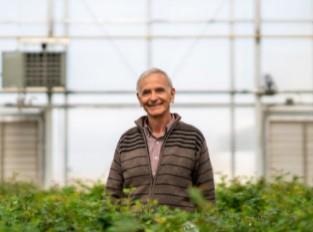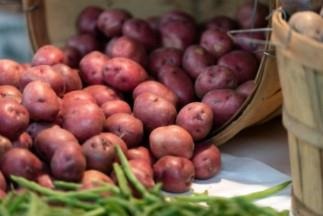Interest and adoption of polyploid computational tools have grown well beyond expectations, providing advances in the breeding of polyploid plants.

David Byrne, Ph.D., Texas A&M AgriLife Research rose breeder and geneticist, is director of a grant-funded project that is a “game changer” for polyploid plant breeding. (Texas A&M AgriLife photo by Sam Craft)
David Byrne, Ph.D., Texas A&M AgriLife Research rose breeder and geneticist, is the director for a four-year grant-funded project to create and improve software for polyploid genetic analysis.
Byrne and Oscar Riera-Lizarazu, Ph.D., AgriLife Research plant geneticist, both in the Texas A&M University Department of Horticulture Sciences, Bryan-College Station, received a $4.3 million in 2020 from the U.S. Department of Agriculture National Institute of Food and Agriculture, NIFA, to develop tools for genomics-assisted breeding in polyploids.
“Polyploid” plants have more than two sets of chromosomes in their cells. Polyploid specialty crops, which include roses, many turfgrasses and food crops like blackberry, potatoes and sweet potatoes, have an annual value of more than $9 billion in the U.S. and many times that value globally.
Polyploid tools ‘game changer’ for plant breeders
One of the project’s goals is to develop computational tools for quantitative trait analyses, genomic selection and haplotype analysis in polyploid crops. Another goal is to train breeders and geneticists to use the tools in public breeding programs for a wide range of ornamental and food crops.
This USDA-NIFA-Specialty Crop Research Initiative grant project includes national and international collaborators in academia from Arkansas, Maine, New York, North Carolina, Oregon, Pennsylvania, Texas, Washington and Wisconsin as well as the Netherlands and New Zealand.
Each of the past two years, the team has held a conference designed to introduce tools to individuals interested in learning how to use them, to gauge the tools’ usefulness, and to guide their evolution.
“We had 300 people in 2021 and only expected around 75,” Byrne said. “There were another 300 this year, and more are expected at future programs. It’s a fairly specialized audience but a very important one, given the wide range of food and ornamental plants these professionals work with. The exciting thing is the number of new faces we see each time.”
Excitement, adoption among participants
Byrne said the conferences have drawn a wide range of industry experts, including plant breeders, molecular and computational geneticists, plant pathologists and physiologists, and entomologists.
Around 30% of participants work with fruit plants, 28% with root or tuber crops, 16% with grasses, and the remaining 26% with ornamental plants, vegetables or cereals.
Plants that will be impacted by polyploid genetic advancement include forage and turfgrasses, fruits like kiwi, strawberries and blackberries, ornamentals from chrysanthemums to roses, and root and tuber crops like potatoes and sweet potatoes.
An exciting element beyond the diversity of the participants’ fields, Byrne said, is that most people were in their 20s and 30s with nearly equal numbers of men and women. Most trainees were also in public plant breeding programs or students. This group will shape breeding programs of the future, he said.
Byrne added that the project is truly an international endeavor with about half of the conferences’ participants attending from organizations outside the U.S.
In 2021, 45% of participants were international, compared to 55% from North America, he said. But this year, 55% of participants were from other nations, with Europe, Africa and South America leading the way, respectively.
Byrne said breakout group sessions and subsequent feedback on the tools during the conferences have been an invaluable element for the technology’s evolution. This evolution is also facilitated by inviting software users to participate in the annual workshop and present their research.
“There is a lot of brainstorming and networking going on, and pulling users together,” he said. “The interactions have led to collaborations on similar projects and use of the tools in actual research.”
Polyploid tool background

New genetic tools that can unlock desired characteristics in polyploid crops like potatoes will propel future plant breeding programs. (Texas A&M AgriLife photo by Laura McKenzie)
The overall project seeks to coordinate research around the computational tool development, to increase training and to improve ease of use, Byrne said. The Polyploid Breeding Community Resource website serves as the repository for the computational toolsets, genomic information, training datasets and materials. An associated YouTube channel contains recordings of all the training presentations given at the workshops.
Despite the importance of polyploid crops, major obstacles for using genomic tools in the past have included a dearth of suitable software and technical expertise. Prior to polyploid tool development, genomic information was only readily used for diploid crops such as corn, rice, soybeans and tomatoes.
Byrne said these computational tools enable the use of genomic information to accelerate the rate of genetic gain in a wide range of polyploid breeding programs, which will lead to a more rapid development of higher quality, more productive and more resilient cultivars.
The software maps polyploid genes, essentially locating phenotypic traits of interest and linking those traits to the associated DNA. The software works with a range of polyploid crops: tetraploids, such as roses, potatoes and blackberries; hexaploids, such as sweet potatoes; octoploids, such as strawberries; decaploids, such as sugarcane; and more.
The software also works well with diploids, and researchers are modifying it to deal with odd ploidy levels such as triploids, which include bananas, hops and seedless watermelons.
The range of applications is drawing more and more interest, which has spurred collaborations and improvements.
“These breeders and programs were all doing similar things but separately,” he said. “There is an advantage to standardized information and sharing ideas and methods, and there is excitement about working out problems.”
Broadening technology, training, application
Byrne said the project is broadening training and accessibility of the tools and expanding their application across the plant breeding field. The software developed is open source, so collaborators can tinker with and improve it.
Reducing the software’s computational requirements is a challenge the team is hoping to address, Byrne said.
There are also plans to make tools more visual, enabling users to see markers in a visual context and allow gene sequence overlays. For instance, contextual and visualized layering would allow users to see where genes are on chromosomes and identify connections with traits of interest.
Byrne is pleased with the technology’s advancement. But he is elated that literature continues to be published on the software and more people are using it more often, clear signs that the user interface and application are headed in the right direction.
“The enthusiasm around the tools is way beyond my expectations,” he said. “It is exciting to see the excitement around it.”
Source : tamu.edu